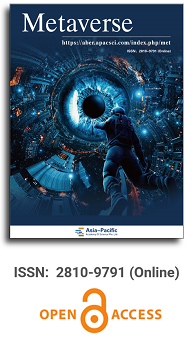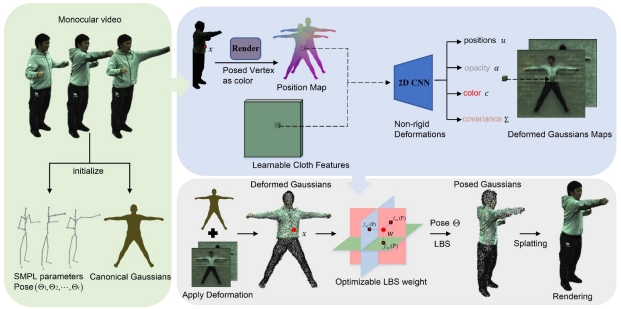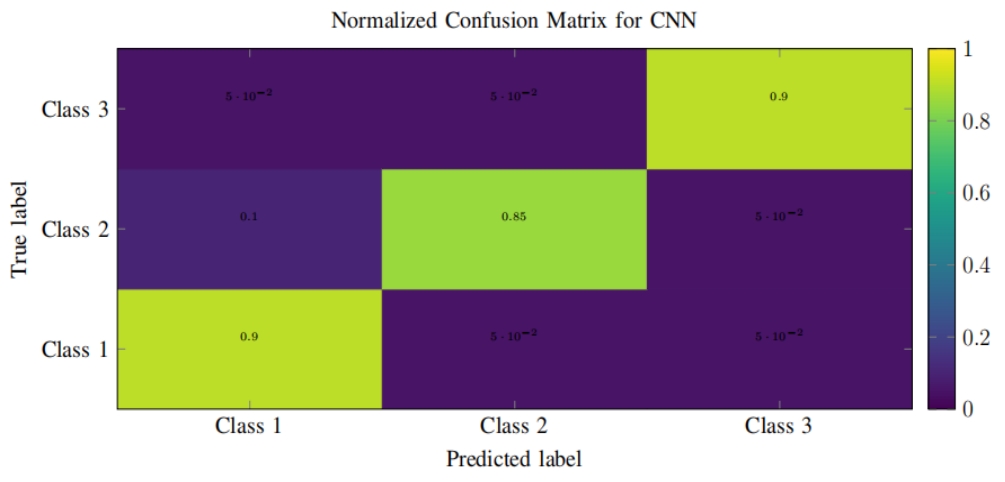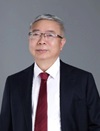
Asia Pacific Academy of Science Pte. Ltd. (APACSCI) specializes in international journal publishing. APACSCI adopts the open access publishing model and provides an important communication bridge for academic groups whose interest fields include engineering, technology, medicine, computer, mathematics, agriculture and forestry, and environment.



From Three-Body game to metaverse
Vol 4, Issue 1, 2023
Download PDF
Abstract
This paper aims to study the concept of the metaverse as reflected in the Three-Body game in the TV series The Three-Body Problem, as well as the current development status of the metaverse in the real world. Firstly, the Three-Body game in The Three-Body problem is analyzed and explained to uncover the underlying metaverse knowledge. Then, through a literature review, the implementation and application scenarios of the metaverse in various industries are investigated from the databases Web of Science and Scopus, using keywords such as “metaverse”, “Three-Body”, “virtual world”, “virtual reality games”, and “human-computer interaction”. Nearly 10,000 relevant articles were retrieved, and 20 articles were selected for in-depth qualitative and quantitative analysis. Subsequently, the content of the literature is summarized from three aspects: the current development status of the metaverse, advancements in virtual reality technology, and advancements in human-computer interaction technology. The application status and technological progress of the metaverse in various industries and the existing technological limitations are discussed. By extending the concept of the metaverse from science fiction, this paper provides research ideas for the future development of the metaverse.
Keywords
References
- Wang F, Qin R, Wang X, et al. Metasocieties in metaverse: Metaeconomics and metamanagement for metaenterprises and metacities. IEEE Transactions on Computational Social Systems 2022; 9(1): 2–7. doi: 10.1109/TCSS.2022.3145165.
- Gaffric G, Peyton W. Liu Cixin’s Three-Body trilogy and the status of science fiction in contemporary China. Science Fiction Studies 2019; 46(1): 21–38. doi: 10.5621/SCIEFICTSTUD.46.1.0021.
- Burger B. Math and magic: Nnedi Okorafor’s Binti trilogy and its challenge to the dominance of Western science in science fiction. Critical Studies in Media Communication 2020; 37(4): 364–377. doi: 10.1080/15295036.2020.1820540.
- Smith TB. The anthropocene in Frank Herbert’s Dune Trilogy. Foundation 2021; 50(140): 62–75.
- Şavkay C. Myth and fantasy in Margaret Atwood’s Maddaddam trilogy. Hacettepe Üniversitesi Edebiyat Fakültesi Dergisi 2019; 36(2): 244–252. doi: 10.32600/huefd.434008.
- Chow J. Zoo-Optics: Mutant ethology and nonhuman visualities in VanderMeer’s Southern Reach Trilogy. Science Fiction Studies 2022; 49 (3): 532–549. doi: 10.1353/sfs.2022.0051.
- Hildenbrand F, Hammer HW. Three-body hypernuclei in pionless effective field theory. Physical Review C 2019; 100(3): 034002. doi: 10.1103/PhysRevC.100.034002.
- Gao J, Hua Y. On the English translation strategy of science fiction from Humboldt’s linguistic worldview—Taking the English translation of Three-Body Problem as an example. Theory and Practice in Language Studies 2021; 11(2): 186–190. doi: 10.17507/tpls.1102.11.
- Dyson SB. Images of international politics in Chinese science fiction: Liu Cixin’s Three-Body Problem. New Political Science 2019; 41 (3): 459–475. doi: 10.1080/07393148.2019.1636567.
- Kshetri N. Web 3.0 and the metaverse shaping organizations’ brand and product strategies. IT Professiona 2022; 24 (02): 11–15. doi: 10.1109/MITP.2022.3157206.
- Buchholz F, Oppermann L, Prinz W. There’s more than one metaverse. i-com 2022; 21(3): 313–324. doi: 10.1515/icom-2022-0034.
- Almarzouqi A, Aburayya A, Salloum SA. Prediction of user’s intention to use metaverse system in medical education: A hybrid SEM-ML learning approach. IEEE Access 2022; 10: 43421–43434. doi: 10.1109/ACCESS.2022.3169285.
- Ljungholm DP. Metaverse-based 3D visual modeling, virtual reality training experiences, and wearable biological measuring devices in immersive workplaces. Psychosociological Issues in Human Resource Management 2022; 10(1): 64–77. doi: 10.22381/pihrm10120225.
- Huggett J. Virtually real or really virtual: Towards a heritage metaverse. Studies in Digital Heritage 2020; 4(1): 1–15. doi: 10.14434/sdh.v4i1.26218.
- Cao X. The multiple bodies of the Three-Body Problem. Extrapolation 2019; 60(2): 183–I. doi: 10.3828/extr.2019.12.
- Qin L. Strategies for translating chinese colloquial expressions into english in science fiction: A case study of English version of the Three-Body Problem. International Journal of Education and Humanities 2023; 6(1): 196–200. doi: 10.54097/ijeh.v6i1.3091.
- Deng G, Goh SS. Star effect and indirect capital preponderance: A case study of The Three-Body Trilogy. Translation and Translanguage in Multilingual Contexts 2022; 8(2): 186–205. doi: 10.1075/ttmc.00091.den.
- Damar M. Metaverse shape of your life for future: A bibliometric snapshot. Journal of Metaverse 2021; 1(1): 1–8.
- Zhao S, Peng Q. Anthropocentrism in 2001: A space odyssey and the Three-Body Problem. Comparative Literature Studies 2020; 57(3): 454–463. doi: 10.5325/complitstudies.57.3.0454.
- Yang C, Lu B, Wang Y. A brief analysis of the English translation version of Ken Liu’s The Three-Body Problem based on the theory of functional equivalence. International Journal of Social Science and Education Research 2021; 4(10): 81–86.
- Erney HG. Ecological science fiction with Chinese characteristics. MOSF Journal of Science Fiction 2021; 5(1): 80–92.
- Şahin Ifo, Çiftçi Te. Metaverse’de gerçekleştirilen işlemlerin vergilendirilmesi (Turkey) [Operations performed in metaverse]. Fiscaoeconomia 2022; 6(2): 677–698. doi: 10.25295/fsecon.1104368.
- Hwang GJ, Chien SY. Definition, roles, and potential research issues of the metaverse in education: An artificial intelligence perspective. Computers and Education: Artificial Intelligence 2022; 3: 100082. doi: 10.1016/j.caeai.2022.100082.
- Erney HG. Ecological science fiction with Chinese characteristics. MOSF Journal of Science Fiction 2021; 5(1): 80–92.
- Long SZ. Paratextual translation strategies of the English version of the Three-Body Problem. Lecture Notes on Language and Literature 2022; 5(1): 18–22. doi: 10.23977/langl.2022.050105.
- Morrison MA. Baoshu: The Redemption of Time: A Three-Body Problem Novel. World Literature Today 2019; 93(4): 107–108.
- Loebbert F, Plefka J, Shi C, et al. Three-body effective potential in general relativity at second post-Minkowskian order and resulting post-Newtonian contributions. Physical Review D 2021; 103(6): 064010. doi: 10.1103/PhysRevD.103.064010.
- Wu Y. Globalization, Science Fiction and the China Story: Translation, dissemination and reception of Liu Cixin’s works across the globe. Critical Arts 2020; 34(6): 56–70. doi: 10.1080/02560046.2020.1850820.
- Dories J. Decentring anthropocentric narcissism: The Novum and the EcoGothic in Cixin Liu’s The Three-Body Problem and Ball Lightning. SARE: Southeast Asian Review of English 2022; 59(1): 110–127.
- Huang Y. The reincarnated giant: An anthology of twenty-first-century Chinese science fiction. Chinese Literature Today 2019; 8(1): 146–147. doi 10.1080/21514399.2019.1618160.
- Steiner P. Modern hard SF: Simulating physics in virtual reality in Cixin Liu’s “The Three-Body Problem”. Lublin Studies in Modern Languages and Literature 2022; 46(3): 57–66. doi: 10.17951/lsmll.2022.46.3.57-66.
- Junker N. Chinese science fiction literature: Can it do for China what K-Pop and Manga do for Korea and Japan?. Asia in Focus: A Nordic Journal on Asia by Early Career Researchers 2019; (7): 24–33.
- Fang K. Rethinking the orwellian imaginary through contemporary Chinese fiction. Surveillance & Society 2019; 17(5): 738–742. doi: 10.24908/ss.v17i5.13458.
- Jian L, Li H. On Chinese science fiction: Selected essays and critical pieces in English, 2015–2020. Science Fiction Studies 2021; 48(3): 537–555. doi: 10.1353/sfs.2021.0061.
- Zhang S. Nationalist allegories in the post-human era. CLCWeb: Comparative Literature and Culture 2021; 22(4): 19. doi: 10.7771/1481-4374.3719.
- Mystakidis S. Metaverse. Encyclopedia 2022; 2(1): 486–497. doi: 10.3390/encyclopedia2010031.
- Kim J. Advertising in the metaverse: Research agenda. Journal of Interactive Advertising 2021; 21(3): 141–144. doi: 10.1080/15252019.2021.2001273.
- Gursoy D, Malodia S, Dhir A. The metaverse in the hospitality and tourism industry: An overview of current trends and future research directions. Journal of Hospitality Marketing & Management 2022; 31(5): 527–534. doi: 10.1080/19368623.2022.2072504.
- Arpaci I, Karatas K, Kusci I, et al. Understanding the social sustainability of the Metaverse by integrating UTAUT2 and big five personality traits: A hybrid SEM-ANN approach. Technology in Society 2022; 71: 102120. doi: 10.1016/j.techsoc.2022.102120.
- Lee JY. A study on metaverse hype for sustainable growth. International Journal of Advanced Smart Convergence 2021; 10(3): 72–80.
- Ante L. The non-fungible token (NFT) market and its relationship with Bitcoin and Ethereum. FinTech 2022; 1(3): 216–224. doi: 10.3390/fintech1030017.
- Barrera KG, Shah D. Marketing in the Metaverse: Conceptual understanding, framework, and research agenda. Journal of Business Research 2023; 155: 113420. doi: 10.1016/j.jbusres.2022.113420.
- Zauskova A, Miklencicova R, Popescu GH. Visual imagery and geospatial mapping tools, virtual simulation algorithms, and deep learning-based sensing technologies in the metaverse interactive environment. Review of Contemporary Philosophy 2022; 21: 122–137. doi: 10.22381/RCP2120228.
- Bansal G, Rajgopal K, Chamola V, et al. Healthcare in Metaverse: A survey on current metaverse applications in healthcare. IEEE Access 2022; 10: 119914–119946. doi: 10.1109/ACCESS.2022.3219845.
- Suh W, Ahn S. Utilizing the metaverse for learner-centered constructivist education in the post-pandemic era: An analysis of elementary school students. Journal of Intelligence 2022; 10(1): 17. doi: 10.3390/jintelligence10010017.
- Ahn SJ, Kim J, Kim J. The bifold triadic relationships framework: A theoretical primer for advertising research in the metaverse. Journal of Advertising 2022; 51(5): 592–607. doi: 10.1080/00913367.2022.2111729.
- Seok WH. Analysis of metaverse business model and ecosystem. Electronics and Telecommunications Trends 2021; 36(4): 81–91. doi: 10.22648/ETRI.2021.J.360408.
- Wiederhold BK. Metaverse games: Game changer for healthcare?. Cyberpsychology, Behavior, and Social Networking 2022; 25(5): 267–269. doi: 10.1089/cyber.2022.29246.editorial.
- Dowling M. Is non-fungible token pricing driven by cryptocurrencies? Finance Research Letters 2022; 44: 102097. doi: 10.1016/j.frl.2021.102097.
- Bao H, Roubaud D. Recent development in fintech: Non-fungible token. FinTech 2021; 1(1): 44–46. doi: 10.3390/fintech1010003.
- Dowling M. Is non-fungible token pricing driven by cryptocurrencies? Finance Research Letters 2022; 44: 102097. doi: 10.1016/j.frl.2021.102097.
- Golf-Papez M, Heller J, Hilken T, et al. Embracing falsity through the metaverse: The case of synthetic customer experiences. Business Horizons 2022; 65(6): 739–749. doi: 10.1016/j.bushor.2022.07.007.
- Müller R. Rechtsprechung zur vermietung von virtuellem land und implikationen für das metaverse am beispiel vom decentraland (German) [Case law of virtual land lease and its implication to metaverse in decentraland’s example]. Umsatzsteuer Rundschau 2022; 71(8): 281–289. doi: 10.9785/ur-2022-710802.
- Rospigliosi PA. Metaverse or simulacra? Roblox, minecraft, Meta and the turn to virtual reality for education, socialization and work. Interactive Learning Environments 2022; 30(1): 1–3. doi: 1080/10494820.2022.2022899.
- Meier C, Saorín J, de León AB, et al. Using the Roblox video game engine for creating virtual tours and learning about the sculptural heritage. International Journal of Emerging Technologies in Learning (iJET) 2020; 15(20): 268–280. doi: 10.3991/ijet.v15i20.16535.
- Han J, Liu G, Gao Y. Learners in the Metaverse: A systematic review on the use of roblox in learning. Education Sciences 2023; 13(3): 296. doi: 10.3390/educsci13030296.
- Chia A. The metaverse, but not the way you think: Game engines and automation beyond game development. Critical Studies in Media Communication 2022; 39(3): 191–200. doi: 1080/15295036.2022.2080850.
- Lee J, Kundu P. Integrated cyber-physical systems and industrial metaverse for remote manufacturing. Manufacturing Letters 2022; 34: 12–15. doi: 10.1016/j.mfglet.2022.08.012.
- Cheng R, Wu N, Chen S, et al. Will metaverse be next internet? Vision, hype, and reality. IEEE Network 2022; 36(5): 197–204. doi: 10.1109/MNET.117.2200055.
- Liu L, Song X, Zhang C, et al. GAN-MDF: An enabling method for multifidelity data fusion. IEEE Internet of Things Journal 2022; 9(15): 13405–13415. doi: 10.1109/JIOT.2022.3142242.
- Özenir İ. Metaverse ve üretim: Metaverse'ün üretime etkileri (Turkey) [Metaverse and production: metaverse influence of Metaverse on production]. Erciyes Akademi 2022; 36(2): 559–573. doi: 10.48070/erciyesakademi.1073659.
- Mourtzis D, Panopoulos N, Angelopoulos J, et al. Human centric platforms for personalized value creation in metaverse. Journal of Manufacturing Systems 2022; 65: 653–659. doi: 10.1016/j.jmsy.2022.11.004.
- Baía Reis A, Ashmore M. From video streaming to virtual reality worlds: An academic, reflective, and creative study on live theater and performance in the metaverse. International Journal of Performance Arts and Digital Media 2022; 18(1): 7–28. doi: 10.1080/14794713.2021.2024398.
- Jin K. Virtual technology in the real world of COVID-19. XRDS: Crossroads, The ACM Magazine for Students 2022; 28(2): 79–79. doi: 10.1145/3495271.
- Zhang Y, Fiore AM, Zhang L, et al. Impact of website design features on experimental value and patronage intention toward online mass customization sites. Journal of Fashion Marketing and Management: An International Journal 2021; 25(2): 205–223. doi: 10.1108/JFMM-11-2019-0261.
- Rosete MEF, Prado G. A experiência do cliente no projecto de design de interiores da Gucci Garden Galleria (Portuguese) [Customer experience of Gucci Garden Galleria interior design project]. DAT Journal 2022; 7(3): 90–103. doi: 10.29147/datjournal.v7i3.650.
- Feng L, Ng GW, Ma L. A review of an interactive augmented reality customization clothing system using finger tracking techniques as input device. In: Alfred R, Lim Y, Haviluddin H, et al. (editors). Computational Science and Technology: 6th ICCST 2019; 2019 Aug 29–30; Kota Kinabalu. Berlin: Springer Link; 2020. p. 457–467.
- Zhang T, Li G, Tayi GK. A strategic analysis of virtual showrooms deployment in online retail platforms. Omega 2023; 117: 102824. doi: 10.1016/j.omega.2022.102824.
- Berman B, Pollack D. Strategies for the successful implementation of augmented reality. Business Horizons 2021; 64(5): 621–630. doi: 10.1016/j.bushor.2021.02.027.
- Tlili A, Huang R, Shehata B, et al. Is Metaverse in education a blessing or a curse: A combined content and bibliometric analysis. Smart Learning Environments 2022; 9(1): 1–31. doi: 10.1186/s40561-022-00205-x.
- Lee H, Hwang Y. Technology-enhanced education through VR-making and metaverse-linking to foster teacher readiness and sustainable learning. Sustainability 2022; 14(8): 4786. doi: 10.3390/su14084786.
- Lee H, Woo D, Yu S. Virtual reality metaverse system supplementing remote education methods: Based on aircraft maintenance simulation. Applied Sciences 2022; 12(5), 2667. doi: 10.3390/app12052667.
- Yu JE. Exploration of educational possibilities by four metaverse types in physical education. Technologies 2022; 10(5): 104. doi: 10.3390/technologies10050104.
- Tchomdji LOK, Park SJ, Kim R. Developing virtual tour content for the inside and outside of a building using drones and matterport. International Journal of Contents 2022; 18(3): 74–84.
- Gao Y. Research on the Disney’s IP brand-building process and shaping tactics. Journal of Education, Humanities and Social Sciences 2022; 5: 81–88. doi: 10.54097/ehss.v5i.2886.
- Dincelli E, Yayla A. Immersive virtual reality in the age of the Metaverse: A hybrid-narrative review based on the technology affordance perspective. The Journal of Strategic Information Systems 2022; 31(2): 101717. doi: 10.1016/j.jsis.2022.101717.
- Pan Y, Kim K, Lee J, et al. Research on the application of digital human production based on photoscan realistic head 3D scanning and unreal engine metahuman technology in the metaverse. The International Journal of Advanced Smart Convergence 2022; 11(3): 102–118. doi: 10.7236/IJASC.2022.11.3.102.
- Alpala LO, Quiroga-Parra DJ, Torres JC, et al. Smart factory using virtual reality and online multi-user: Towards a metaverse for experimental frameworks. Applied Sciences 2022; 12(12): 6258. doi: 10.3390/app12126258.
- Durana P, Krulicky T, Taylor E. Working in the metaverse: virtual recruitment, cognitive analytics management, and immersive visualization systems. Psychosociological Issues in Human Resource Management 2022; 10(1): 135–148. doi: 10.22381/pihrm101202210.
- Hawkins M. Virtual employee training and skill development, workplace technologies, and deep learning computer vision algorithms in the immersive metaverse environment. Psychosociological Issues in Human Resource Management 2022; 10(1): 106–120. doi: 10.22381/pihrm10120228.
- Schweitzer JB, Rizzo AS. Virtual Reality and ADHD: Clinical assessment and treatment in the metaverse. The ADHD Report 2022; 30(3): 1–9. doi: 10.1521/adhd.2022.30.3.1.
- Koo H. Training in lung cancer surgery through the metaverse, including extended reality, in the smart operating room of Seoul National University Bundang Hospital, Korea. Journal of Educational Evaluation for Health Professions 2021; 18: 33–33. doi: 10.3352/jeehp.2021.18.33.
- Lo SC, Tsai HH. Design of 3D virtual reality in the metaverse for environmental conservation education based on cognitive theory. Sensors 2022; 22(21): 8329. doi: 10.3390/s22218329.
- Gadalla E, Keeling K, Abosag I. Metaverse-retail service quality: A future framework for retail service quality in the 3D internet. Journal of Marketing Management 2013; 29(13–14): 1493–1517. doi: 1080/0267257X.2013.835742.
- Adams D. Virtual retail in the metaverse: Customer behavior analytics, extended reality technologies, and immersive visualization systems. Linguistic and Philosophical Investigations 2022; (21): 73–88. doi: 10.22381/lpi2120225.
- Han DID, Bergs Y, Moorhouse N. Virtual reality consumer experience escapes: Preparing for the metaverse. Virtual Reality 2022; 26(4): 1443–1458. doi: 10.1007/s10055-022-00641-7.
- Tran NC, Wang JH, Vu TH, et al. Anti-aliasing convolution neural network of finger vein recognition for virtual reality (VR) human–robot equipment of metaverse. The Journal of Supercomputing 2023; 79(3): 2767–2782. doi: 10.1007/s11227-022-04680-4.
- Kozinets RV. Immersive netnography: A novel method for service experience research in virtual reality, augmented reality and metaverse contexts. Journal of Service Management 2023; 34(1): 100–125. doi: 10.1108/JOSM-12-2021-0481.
- Kwok CP, Tang YM. A fuzzy MCDM approach to support customer-centric innovation in virtual reality (VR) metaverse headset design. Advanced Engineering Informatics 2023; 56: 101910.
- Shin D. The actualization of meta affordances: Conceptualizing affordance actualization in the metaverse games. Computers in Human Behavior 2022; 133: 107292. doi: 10.1016/j.chb.2022.107292.
- Egliston B, Carter M. Critical questions for Facebook’s virtual reality: Data, power and the Metaverse. Internet Policy Review 2021; 10(4): 1–23. doi: 10.14763/2021.4.1610.
- Hancock K. Geospatial mapping and remote sensing technologies, spatial cognition and visual perception algorithms, and virtual navigation and ambient scene detection tools across the blockchain-based metaverse. Analysis and Metaphysics 2022; (21): 227–243. doi: 10.22381/am21202214.
- Kim HK, Jeong H, Park J, et al. Development of a comprehensive design guideline to evaluate the user experiences of meal-assistance robots considering human-machine social interactions. International Journal of Human–Computer Interaction 2022; 38(17): 1687–1700. doi: 10.1080/10447318.2021.2009672.
- Sun Z, Zhu M, Shan X, et al. Augmented tactile-perception and haptic-feedback rings as human-machine interfaces aiming for immersive interations. Nature Communications 2022; 13(1): 5224. doi: 10.1038/s41467-022-32745-8.
- Le X, Shi Q, Sun Z, et al. Noncontact human–machine interface using complementary information fusion based on mems and triboelectric sensors. Advanced Science 2022; 9(21): 2201056. doi: 10.1002/advs.202201056.
- Panagiotakopoulos D, Marentakis G, Metzitakos R, et al. Digital scent technology: Toward the internet of senses and the metaverse. IT Professional 2022; 24(3): 52–59. doi: 10.1109/MITP.2022.3177292.
- Lv Z, Xie S, Li Y, et al. Building the metaverse by digital twins at all scales, state, relation. Virtual Reality & Intelligent Hardware 2022; 4(6): 459–470. doi: 10.1016/j.vrih.2022.06.005.
- Liang H, Li J, Wang Y, et al. Metaverse virtual social center for the elderly communication during the social distancing. Virtual Reality & Intelligent Hardware 2023; 5(1): 68–80. doi: 10.1016/j.vrih.2022.07.007.
- Lee J, Lee TS, Lee S, et al. Development and application of a metaverse-based social skills training program for children with autism spectrum disorder to improve social interaction: Protocol for a randomized controlled trial. JMIR research protocols 2022; 11(6): e35960. doi: 10.2196/35960.
- Gao Y, Lu Y, Zhu X. Mateverse, the future materials science computation platform based on metaverse. The Journal of Physical Chemistry Letters 2022; 14: 148–157. doi: 10.1021/acs.jpclett.2c03459.
- Arif YM, Hayati HN. Learning material selection for metaverse-based mathematics pedagogy media using multi-criteria recommender system. International Journal of Intelligent Engineering and Systems 2022; 15(6): 541–551. doi: 10.22266/ijies2022.1231.48.
- Wang Q, Tang L, Wang Y. Potential applications of the metaverse in higher English education. Open Journal of Social Sciences 2023; 11(1): 450–459. doi: 10.4236/jss.2023.111031.
- Jovanović A, Milosavljević A. VoRtex Metaverse platform for gamified collaborative learning. Electronics 2022; 11(3): 317. doi: 10.3390/electronics11030317.
- Siyaev A, Jo GS. Towards aircraft maintenance metaverse using speech interactions with virtual objects in mixed reality. Sensors 2021; 21(6): 2066. doi: 10.3390/s21062066.
- Brik B, Moustafa H, Zhang Y, et al. Guest editorial: Multi-access networking for extended reality and metaverse. IEEE Internet of Things Magazine 2023; 6(1): 12–13. doi: 10.1109/MIOT.2023.10070411.
Supporting Agencies
Copyright (c) 2023 Zhihan Lv

This work is licensed under a Creative Commons Attribution 4.0 International License.

This site is licensed under a Creative Commons Attribution 4.0 International License (CC BY 4.0).

Prof. Zhigeng Pan
Professor, Hangzhou International Innovation Institute (H3I), Beihang University, China

Prof. Jianrong Tan
Academician, Chinese Academy of Engineering, China
Conference Time
December 15-18, 2025
Conference Venue
Hong Kong Convention and Exhibition Center (HKCEC)
...
Metaverse Scientist Forum No.3 was successfully held on April 22, 2025, from 19:00 to 20:30 (Beijing Time)...
We received the Scopus notification on April 19th, confirming that the journal has been successfully indexed by Scopus...
We are pleased to announce that we have updated the requirements for manuscript figures in the submission guidelines. Manuscripts submitted after April 15, 2025 are required to strictly adhere to the change. These updates are aimed at ensuring the highest quality of visual content in our publications and enhancing the overall readability and impact of your research. For more details, please find it in sumissions...






.jpg)
.jpg)

